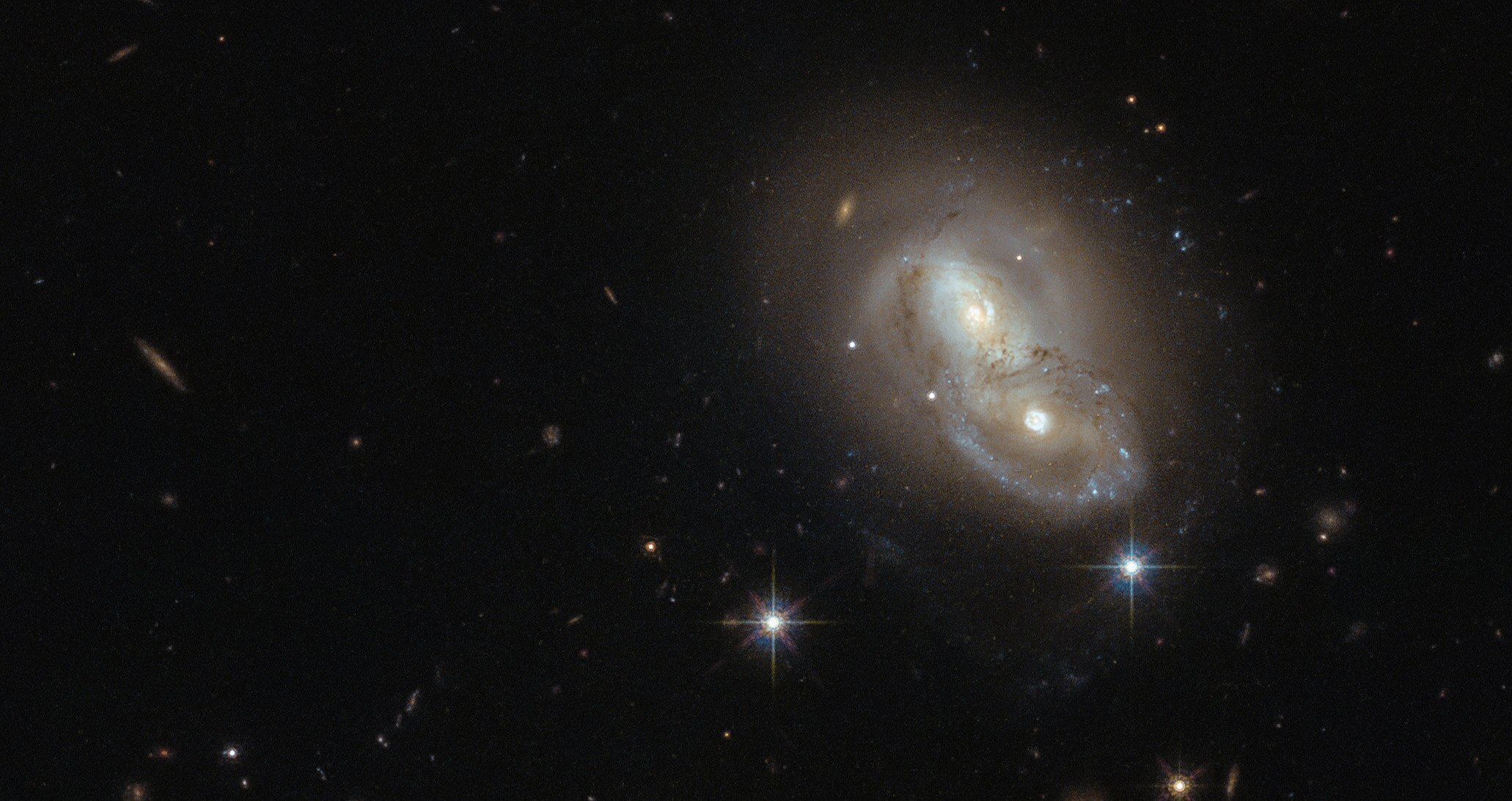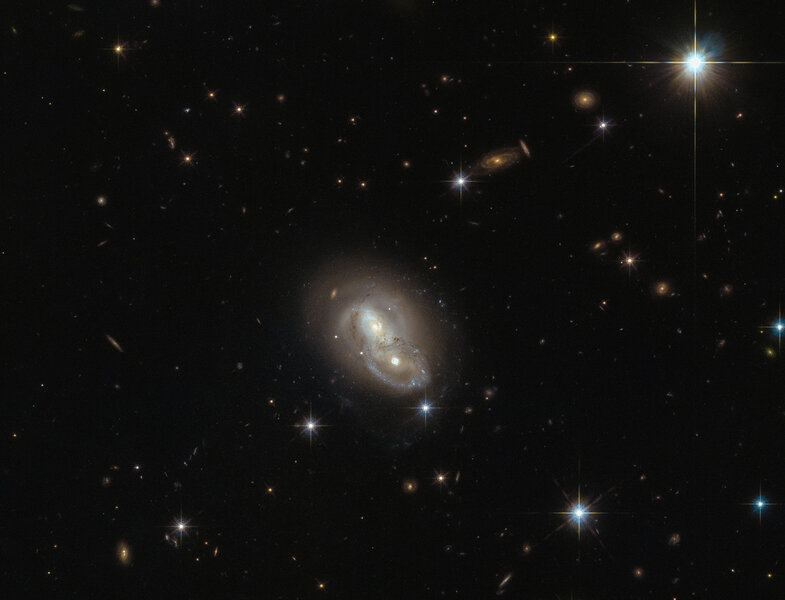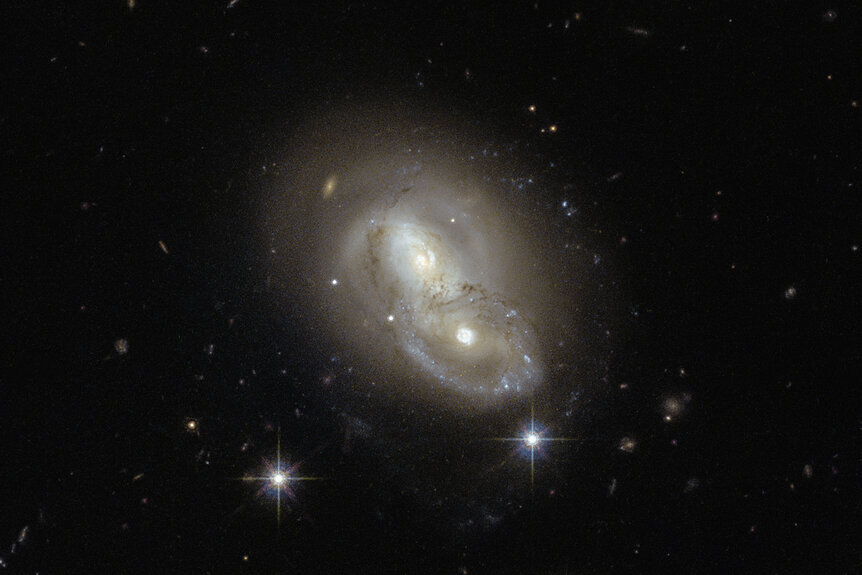Create a free profile to get unlimited access to exclusive videos, sweepstakes, and more!
Two galaxies that pass in the night. Rapidly.

The Universe seems like a fairly quiet place at first glance. Night after night things don't seem to move much, and with all that room out there it seems like a close encounter between two objects would be rare.
But even though the volume of space is vast, there are a lot of things in it, including a couple of trillion galaxies. Many of them are in clusters, with hundreds or even thousands of galaxies, so interactions are the norm. But even in deeper space, galaxies do sometimes slide a bit too close for comfort. Sometimes more than once.
And that brings us to the mouth-fully named IRAS 06076-2139. For a long time it was thought to be a somewhat oddly constructed galaxy, maybe a big elliptical with two cores (which happens sometimes after two galaxies collide). But then astronomers pointed Hubble at it, and what they got was a surprise. A series of them!
It's not one galaxy, but two! They look like two spiral galaxies that appear to be interacting in some way. How exactly is unclear. At least, until another team of astronomers used the Very Large Telescope in Chile to take spectra of the galaxies, breaking the light from them into very finely divided colors, useful for determining the velocities of all the different components. And what they found turned out to be another surprise.
If the galaxies are interacting, it's a pretty mild event. They don't seem to be affecting each other all that much. It's hard to say how close they really are to each other in space, even though from our point of view they appear to overlap. The galaxy to the south (to the lower right) is the one closer to us, though: The dust in its arms blocks light from the somewhat bigger galaxy to the north (upper left). So the southern galaxy must be in front.
However, there's a lot of evidence for some kind of interaction in the past. The southern galaxy has that loooong arm seen in silhouette extending across the northern galaxy, and actually emerges on the other side as a series of bluish clumps to the upper right, just outside the glowing edge of the northern galaxy (that arm extends for 40,000 light-years, a pretty decent distance). Those clumps are knots of star formation, gas clouds forming thousand of stars. The brightest are hot and blue, and they dominate the light we see there.
But there's more. Look at the center of the southern galaxy. The nucleus looks like just a fuzzy knot, but if you look more closely you'll see that surrounding the very small core is a ring of light. The astronomers looked at the shape and velocity of that ring and found it to be expanding, like a ripple growing from the spot in a pond where a rock was thrown in.
That's an apt analogy: It looks like the southern galaxy did indeed suffer a collision, but it was 140 million years ago with an entirely different galaxy!! A smaller dwarf galaxy plowed right through the center of it, and the gravity from that interaction carved out that ring, an expanding wave moving outward at 70 kilometers per second. These kinds of ring galaxies aren't common, but they are spectacular.
That long sweeping spiral arm from the southern galaxy is also likely from a past interaction as well, possibly different than the one that formed the ring, too. It looks like that galaxy has had an interesting past.
This pair was found in a survey of the sky taken by the Infrared Astronomical Satellite, which mapped the sky in 1983. It appears as a very bright splotch, meaning it was pouring out infrared light. In fact, this kind of galaxy is called a ULIRG, for Ultra-Luminous Infrared Galaxy. Usually they have a lot of dust — grains of rocky or sooty material generally made when stars age and die — which is very good at absorbing light. The dust then warms up and emits IR light. You need a lot of stars to make this much dust, so these galaxies tend to be churning out stars rapidly.
Looking at these galaxies in the Hubble image, though, they don't seem to be forming stars at a particularly high rate. However, it looks like a lot of the star formation is in the nuclei, where there's so much dust that it blocks our direct view of the stars there.
If your head is spinning a bit after all this, well, yeah. And I left out a lot of details! Sometimes you can just look at an image and some supplemental data and the picture becomes clear. But in this case you get subtlety on top of subtlety, and it can be hard to figure out just what's going on.
And what of these two galaxies? What does time have in store for them? Sometimes interacting galaxies do so in such a way that they eventually merge, becoming one bigger galaxy. Will that happen here?
The eventual fate of the galaxies is unclear, but there is one thing we do know: It's not with each other. They are screaming past each other at a velocity of at least 550 kilometers per second — 2 million kilometers per hour, fast enough to cross the diameter of our entire planet in 20 seconds. That's so fast that there's no chance they'll slow down. They'll just keep moving on.
Of course, galaxies are big, and even at their ridiculous speed, from our point of view it'll take 50 million or so years for these two to pass each other. That's a long time for humans, but a fleeting moment in the lifespan of galaxies. I'm glad we caught these two while we could.
















